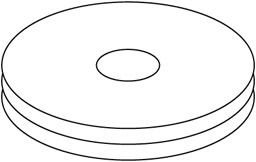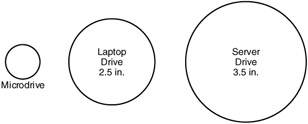Chapter 1: Hard Disks and How They are Organized
|
| < Day Day Up > |
|
While disk drives have been around since the 1950s, like anything else the technology keeps evolving. As a result, the assortment of options on the market available for data storage is expanding. Selecting the best disk drive for any particular operation and keeping it running at its best require an understanding of the hardware components, as well as how the data is stored and the terminology used by the manufacturers in describing their products. Only then can a correct comparison be made. This chapter provides details about the basic components and architecture of the hard disk and methods to improve its performance.
An understanding of the basic components of the hard disk and how they operate together — as well as the different paradigms for storing data and factors affecting disk performance — makes it easier to select the optimum storage solution for a particular project or installation. Following is a discussion of the basics of hard disks, including their physical components, how the data is stored, and factors that should be considered when comparing disk performance. Also examined are several tried and tested strategies that will help to improve overall drive performance.
Hardware Components of the Hard Drive
Any hard drive has several major components. Below, we briefly outline the core components; other items, such as cabling and connectors, are not covered here.
Platters
While the terms hard drive and hard disk are used interchangeably, hard drives typically contain multiple disks, or platters, stacked on top of each other (Exhibit 1). Personal computer (PC) hard drives generally have one to five platters, while servers will have up to a dozen. (The first disk drive, IBM's RAMAC, had a stack of 50 24-inch platters, each holding 100 K.)
Exhibit 1: Platters

The platter is the element that actually stores the data. It consists of a substrate coated with magnetic media. The substrate, made out of a nonmagnetic material, is there to act as a rigid support for the magnetic media. Traditionally, alloys made of aluminum have been used for hard drives, but to meet the demands of higher performance drives the industry is gradually transitioning toward the use of glass, magnesium, and other substances that provide greater rigidity, smoothness, and overall thermal stability. Switching to these newer materials allows manufacturers to create thinner disks and, perhaps more importantly in the long run, to operate them at higher speeds.
On top of the substrate goes a coating of magnetic media. Originally, this was a thin layer (less than 1 micron) of iron oxide. More recently, however, manufacturers have been replacing this by applying an even thinner coating of magnetic material using vacuum deposition, the same process used in manufacturing computer chips. The magnetic layer is then covered by a protective layer of carbon and a lubrication layer to prevent damage in case the head comes in contact with the platter surface. In most cases, both sides of the platter are coated with magnetic media. Why? The goal in coating both sides is to increase the "areal density" of the platter — the amount of data that can be stored in a given amount of space. Increasing areal density is what has continuously increased the capacity and brought down the prices of storage. A 3.5-inch floppy, for example, is the same size as the typical hard disk platter, but hard disk platters typically hold about 30,000 times as much data — 40 gigabytes (GB) — due to greater areal density, and this capacity will certainly increase even further in the coming years.
In 2001, for example, Seagate Technology demonstrated a drive with an areal density of 100 gigabits (Gb) per square inch. Such disks would make it possible to store 125 GB of capacity on a single 3.5-inch platter. While drives built using that technology were not commercially available at the time of this writing, in June 2003 Western Digital released a 250-GB drive with over 80 GB per platter. It is only a matter of time before 125-GB disks are widely available on the market.
Interestingly, as areal density has increased, the size of platters has dropped. The typical server and workstation now have drives with a nominal 3.5-inch form factor, and the platters themselves are about 3.74 inches. This configuration has several advantages. Smaller platters are more rigid that larger ones, allowing the read/write heads to float closer to the surface. Also, the disks can spin faster, resulting in more rapid data access. High-performance drives, with speeds of 10,000 to 15,000 rotations per minute (rpm), achieve this speed by using even smaller disks (2.5 to 3.0 inches), thus trading lower storage capacity for quicker data access. Laptops, for example, typically utilize 2.5-inch platters, and the platter in IBM's Microdrive, which is used in devices such as digital cameras, is a mere 1 inch yet holds up to 1 GB (Exhibit 2).
Exhibit 2: Disk Sizes

Spindle/Motor
The platters are attached at the center to a spindle that is directly attached to the shaft of the motor. No belts or gears are used, as they could result in slippage and rotational speed variability; instead, the motors use a closed-loop feedback system to precisely control the speed.
Shock and vibration can cause the read/write heads to slap the disk surface, resulting in lost data and other damage, which is why spindle motors are specifically designed for minimal vibration. Even so, vibration is still a problem for manufacturers, one that worsens as rotational speeds increase. Newer rackdense server installations, for instance, are beginning to experience vibration-related hard drive problems.
Fortunately, vibration is less of an issue in server installations thanks to some recent technological breakthroughs. In July 2002, for example, IBM released a new technology called Rotational Vibration Safeguard (RVS), which is designed to improve performance in large disk arrays by sensing the direction and intensity of the vibration on a disk and canceling it out. The first product to use RVS is IBM's Ultrastar 146Z10, a 148-GB drive running at 10,000 rpm.
While servers and workstations do occasionally suffer damage from shock, it is particularly a problem for portable devices. Mobile disks address this issue by adding cushioning to absorb and minimize impact, by stiffening components (including the spindle motor and head arms), and through design changes such as the use of smaller platters.
Head-Actuator Assembly
The head-actuator assembly consists of four principal components: the actuator, the arms, the sliders, and the read/write heads. The actuator is the device that moves the arms containing the read/write heads across the platter surface in order to store or retrieve information. While early disk drives used a stepper motor, and floppy drives still do, hard drives require something more accurate. Because platters now contain as many as 30,000 tracks per inch, precise location control is essential for locating positions on the disks. This is complicated by the fact that, given the tight tolerances involved, thermal expansion and contraction of components causes slight shifts in the location of the data. Today's actuators, therefore, are much more advanced than even recent predecessors. They consist of an electromagnetic positioning device coupled with a feedback servo mechanism to ensure that the heads are properly aligned to the disks.
The head arms move between the platters in order to store and access the data; however, it is important to understand that they all move together as a group, rather than each moving independently. At the end of each arm is a head slider. The slider is a block of material that holds the read/write head and acts as an airfoil to keep it positioned at the precise height above the surface of the platter. The lighter the arm and slider, the easier it is for the actuator to move them to the correct location, thus resulting in faster data access.
The read/write head converts the electronic 0s and 1s into the magnetic fields on the disk. Each arm used to have a single read/write head, but separate heads are now available to perform the reading and writing as distinct functions. The write head is the same type as used in earlier designs, but the read head is far more sensitive. From a design and manufacturing standpoint, this means that weaker magnetic fields can be used so that the data can be packed much more tightly together.
Logic Board
To run the various components that comprise the modern hard drive, disk drives contain their own logic boards. Mounted on these boards are a microprocessor, memory chips, and many other more minor components. The logic board itself is there to control the disk rotational speed and to direct the actuator in all its motions. In addition, it performs the process of transferring data from the computer to the magnetic fields on the disk. (This data is encoded rather than being a straight one-to-one translation due to the differing properties of electricity and magnetism.) One function that can lead to improved performance, particularly with servers, is optimizing the order in which data is retrieved in order to minimize the head movement and improve access time. This feature is less critical with workstations.
Cache
Even though disk drives are much faster than they used to be, they are still much slower than other components in the computer (Exhibit 3). Compared with the central processing unit (CPU) and random-access memory (RAM), the disk is a severe performance bottleneck in a computer. Even a high-speed server drive has a seek time of over 4 ms, which means it is able to perform fewer than 250 operations per second. While this speed is impressive relative to what used to be available, it is still way too slow when processors are running at over 2 gigahertz (GHz). A way to speed up operations is to store the most recently accessed data in memory; therefore, drives now come with several megabytes of cache.
Exhibit 3: Relative Speed of Components

Controller
In addition to the logic board contained in the drive itself, today's disks have controllers. These can come as either a controller card or an integrated controller on the motherboard.
|
| < Day Day Up > |
|
EAN: N/A
Pages: 197